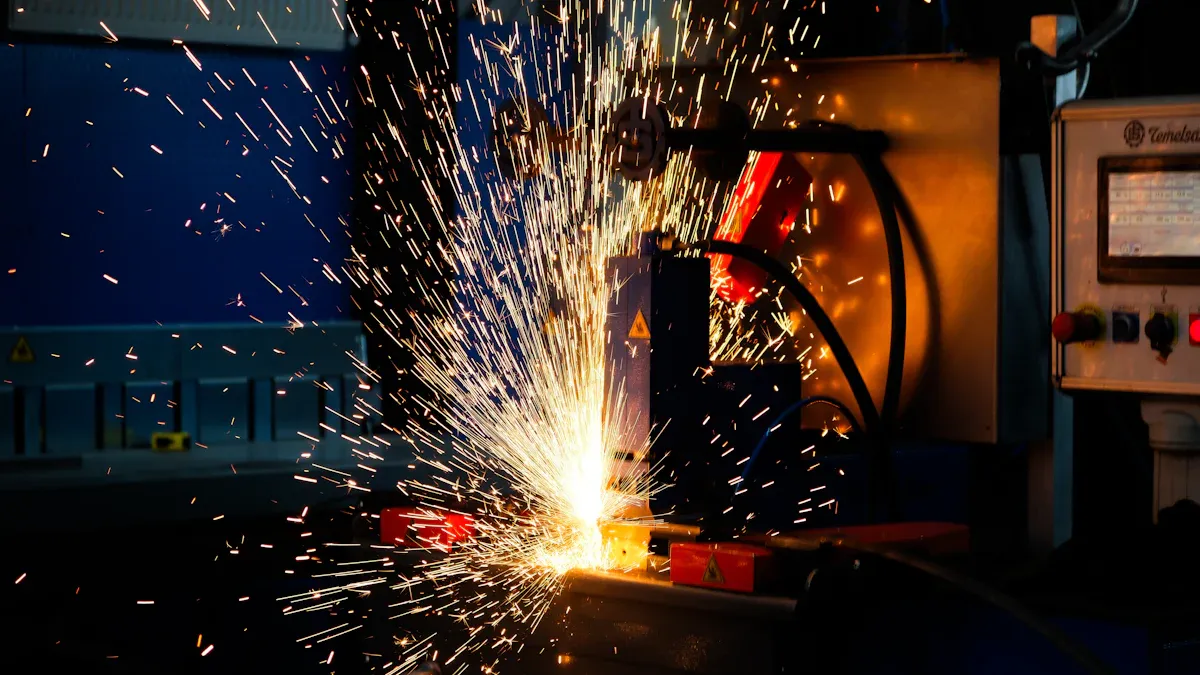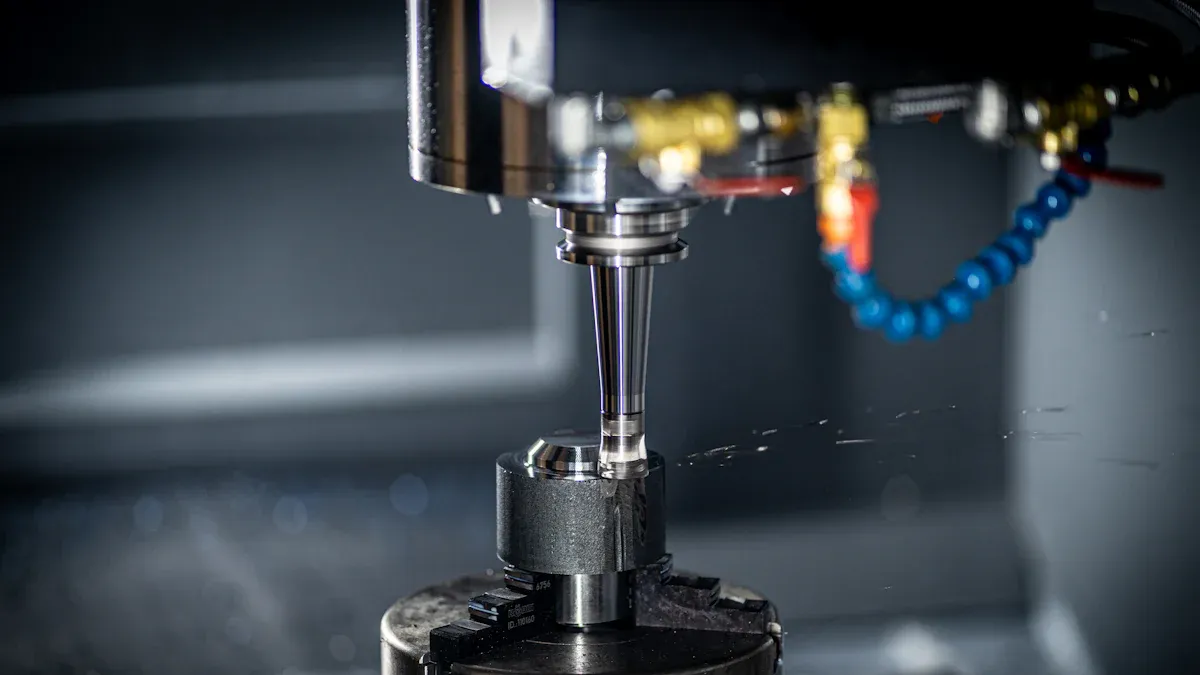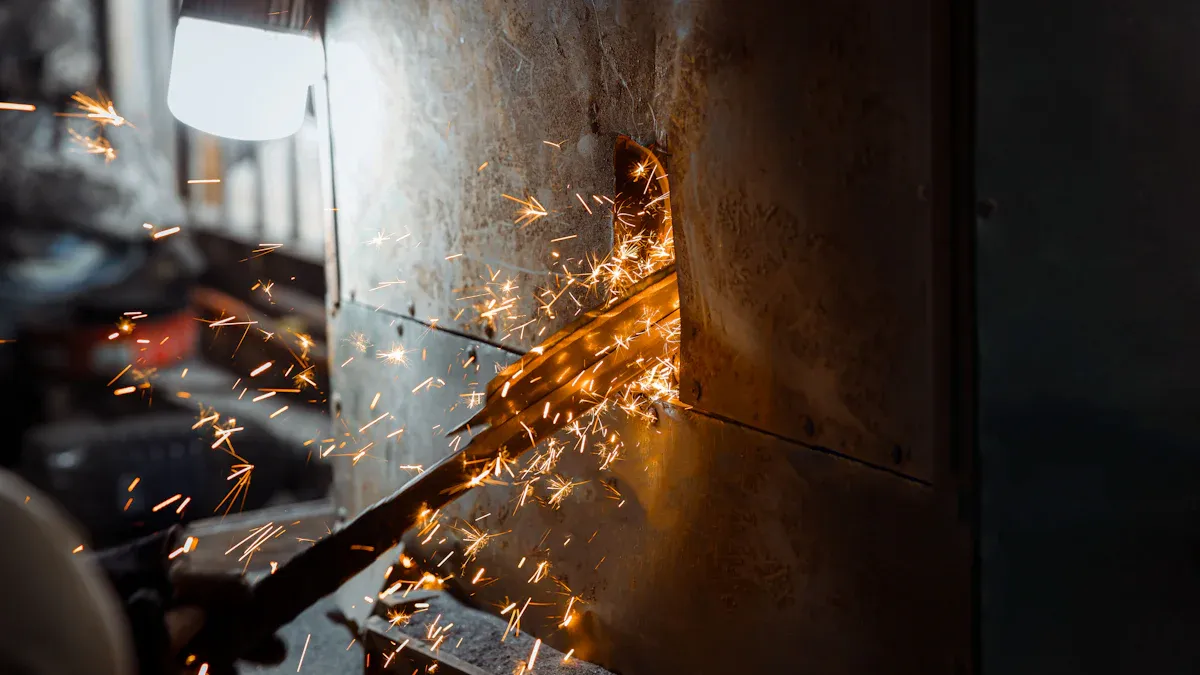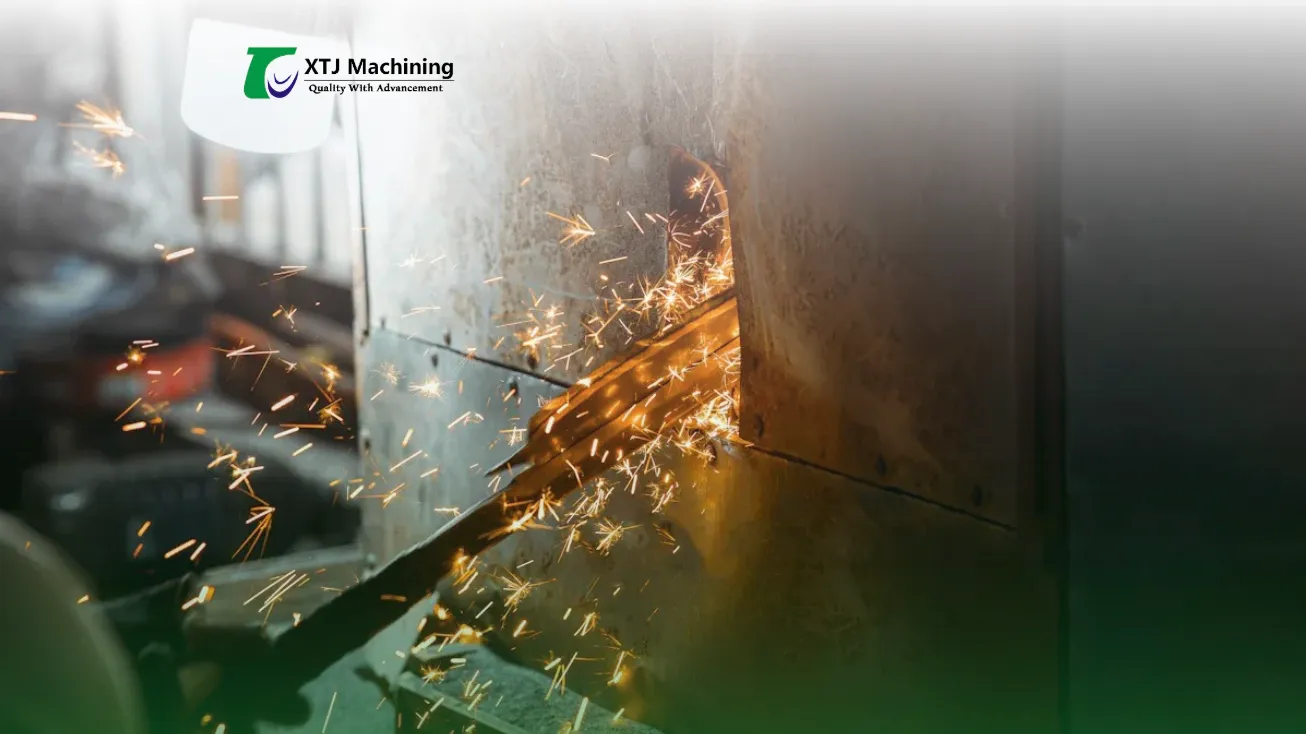You should know the main difference between metal fabrication and machining. Metal fabrication shapes and connects metal pieces. Machining takes away material from a solid block to make exact parts. If you know this difference, you can pick the right process for your project. This helps you get the best results. It saves resources and makes sure your parts fit your needs. XTJ Precision Mfg uses both methods to give custom solutions for many industries.
Key Takeaways
- Metal fabrication changes and connects metal pieces by cutting, bending, and welding. It works best for big or simple parts. Machining takes away material from solid blocks to make exact, detailed parts with tight fits. You should pick the right process based on your part’s size, shape, detail, and material. This helps save time and money. Fabrication uses tools like shears and rollers. Machining uses CNC machines for better accuracy and harder shapes. XTJ Precision Mfg gives expert help and both services. They help you get strong, accurate parts for your project.
Metal Fabrication Overview

What Is Metal Fabrication
Metal fabrication means turning raw metal into finished parts. You begin with metal sheets, bars, or tubes. These pieces get shaped, cut, and joined to make new things. The main steps are cutting, bending, and welding. Cutting splits metal into smaller parts. Bending makes the metal form angles or curves. Welding connects two or more pieces to make them strong. These steps often happen together in one project.
XTJ Precision Mfg has advanced sheet metal fabrication services. You can order custom parts made with great accuracy. Their team uses modern machines to cut, bend, and finish metal. You can also get surface treatments like anodizing or powder coating. These treatments help parts last longer and look better.
Common Fabrication Methods
There are many ways to do metal fabrication. Each way helps you get a different result. Here is a table that shows some common processes and how often they are used:
| Process | Frequency/Usage in Industry | Typical Applications/Industries |
|---|---|---|
| Roll Forming | Highly efficient, preferred for high-volume runs | Aerospace, automotive, construction, HVAC, metal building |
| Extrusion | Efficient for complex cross-sections, long lengths | Agriculture, construction, electronics, military |
| Press Braking | Best for smaller runs, simpler bend patterns | Architecture, electronics, industrial manufacturing |
| Stamping | Ideal for high-volume, consistent, intricate parts | Appliances, construction, electrical, hardware manufacturing |
| Forging | Produces strong, durable parts, less secondary work | Aerospace, automotive, medical, power generation |
| Casting | Suitable for complex shapes, smaller runs | Various industries requiring detailed parts |
You also use cutting, bending, assembling, and welding in almost every project. Modern machines like CNC punch presses and press brakes help you work fast and get exact results.
Typical Uses
Metal fabrication is used in many industries. You see it in cars, airplanes, buildings, and electronics. It helps make car frames, airplane parts, and building supports. Computer cases are made this way too. In food factories, you find stainless steel tanks and platforms. In energy, you see pipelines and wind turbine parts. Medical tools, mining equipment, and vending machines also use fabricated metal parts.
Tip: If you need custom metal parts, XTJ Precision Mfg can help. Their sheet metal fabrication and finishing services give you strong and accurate parts for any industry.
Machining Explained

What Is Machining
Machining makes parts by taking away material from a solid block. You begin with metal or plastic. Machines cut, drill, or grind off the extra pieces. This is called subtractive manufacturing. It is not the same as additive manufacturing. Additive manufacturing builds parts one layer at a time. You can look at the table below to see the main differences:
| Feature | Additive Manufacturing | CNC Machining |
|---|---|---|
| Process | Adds material layer by layer | Removes material from a block |
| Design Freedom | High, complex shapes possible | Moderate, limited by tool paths |
| Precision | Moderate | High, tight tolerances |
| Surface Finish | Often rough, needs post-processing | Smooth to very smooth |
| Production Costs | Higher for large volumes | Cost-effective for large-scale production |
| Applications | Prototyping, custom parts | Precision parts, wide material range |
XTJ Precision Mfg uses advanced CNC machines for very accurate parts. You can get parts with tolerances as close as ±0.002mm. Their CNC machining and prototyping services help you turn ideas into real products fast.
Main Machining Techniques
There are many ways to use machining for different shapes and finishes. Here are some common methods:
- Turning: Spins the part while a cutting tool shapes it. You use this for shafts and threads.
- Milling: Uses spinning tools to cut flat or complex shapes. This works well for gears and slots.
- Drilling: Makes holes in many sizes and depths.
- Grinding: Makes surfaces smooth for a fine finish.
- EDM (Electrical Discharge Machining): Cuts hard metals using electric sparks.
- Broaching: Cuts keyways or special shapes inside holes.
XTJ Precision Mfg has more than 120 CNC machines. These include 3-axis and 5-axis centers. You can pick from many materials like aluminum, steel, titanium, and plastics.
Applications in Industry
Machining is used in many industries. It is needed for car parts, airplane parts, and medical devices. Builders use machining for hardware and tools. You also see it in electronics, energy, and home appliances. Machining helps you get strong and exact parts for almost any project.
Tip: If you need high-precision parts or prototypes, XTJ Precision Mfg gives fast and reliable CNC machining services for many industries.

Metal Fabrication and Machining Compared
Process Differences
Metal fabrication and machining are not the same. Metal fabrication shapes and joins metal using steps like cutting, bending, and welding. You usually start with flat sheets or bars. These get changed into new shapes without taking away much material. Machining is different. It removes material from a solid block to make the part. Sharp tools cut away the extra until you have the right shape.
Here is a table that shows how the two processes are different:
| Aspect | Metal Fabrication | Machining |
|---|---|---|
| Workflow | Designing, cutting, forming (bending, rolling), assembling (welding or fastening), finishing | Removing material with tools (milling, turning, drilling, grinding) |
| Material Handling | Works with sheets or bars, reshapes and joins parts | Starts with solid blocks or rods, removes material to shape |
| Process Nature | Combines forming, joining, and finishing | Focuses on precise material removal |
| Application Focus | Best for larger parts, simple or complex shapes, high production runs | Best for high-precision, complex parts, prototypes, and low to medium volumes |
Metal fabrication is good for big parts and lots of them. Machining is better for small, detailed, and exact parts.
Note: XTJ Precision Mfg uses both methods. You can get custom parts for any project, big or small.
Tools and Precision
The tools for metal fabrication and machining are not the same. Fabrication uses machines like shears, brakes, rollers, and laser cutters. These tools shape and join metal. They usually make parts with tolerances of about 0.1 to 0.2 mm. This is good for many jobs, but not all.
Machining uses computer-controlled tools like CNC mills, lathes, and grinders. These machines cut metal or plastic with very high accuracy. They can make parts with tolerances as small as a few microns (0.003–0.005 mm). You can get shapes and details that are hard to make with fabrication.
Here is a table to compare the tools:
| Aspect | Metal Fabrication Tools | Machining Tools (CNC) |
|---|---|---|
| Processes | Cutting, welding, bending, finishing | Milling, turning, boring, grinding, engraving |
| Typical Materials | Sheet metals (steel, aluminum, stainless) | Metals, plastics, composites |
| Precision Tolerance | 0.1 – 0.2 mm (hundred microns) | 0.003 – 0.005 mm (few microns) |
| Capability | Simple to moderate shapes, limited complexity | Complex shapes, intricate designs |
| Equipment Examples | Shears, brakes, rollers, laser cutters | CNC mills, lathes, grinders |
Pick machining if you need very exact or complex parts. Fabrication is best for bigger, simpler shapes.
Tip: XTJ Precision Mfg offers both CNC machining and sheet metal fabrication. You can get the right part for your needs.
End Products
The finished parts from fabrication and machining are different. Machined parts have complex shapes, tight tolerances, and smooth surfaces. You see these in engines, medical tools, and electronics. Fabricated parts are usually simpler. They are flat or bent and used for things like enclosures, brackets, and frames.
Here is a table to help you compare:
| Aspect | CNC Machining Products | Sheet Metal Fabrication Products |
|---|---|---|
| Complexity | High, with intricate 3D shapes and internal features | Simpler, mostly flat or bent profiles |
| Geometry | Complex 3D, tight tolerances | 2D profiles with bends, folds, welds |
| Dimensional Accuracy | ±0.001–0.005 inches | ±0.005–0.030 inches |
| Surface Finish | Superior, minimal post-processing | Rougher, often needs extra finishing |
| Typical Products | Engine parts, medical devices, electronics | Enclosures, brackets, panels, ducts |
Use machining for parts that need fine details and high accuracy. Fabrication is better for bigger, less detailed parts.
XTJ Precision Mfg can do both fabrication and machining. You can get custom parts for any design, simple or complex.
Choosing the Right Process
Project Needs
First, think about what your project needs. Look at the size, shape, and details of your part. If your part is simple and flat, use sheet metal fabrication. This works well for things like enclosures and brackets. If your part is complex or has small spaces, choose CNC machining. Machining can make grooves, threads, and pockets that are hard to do with fabrication.
Here is a table to help you compare:
| Factor | Sheet Metal Fabrication | CNC Machining |
|---|---|---|
| Design Complexity | Best for simple, flat, or bent shapes | Best for detailed, intricate, or 3D shapes |
| Durability & Strength | Good for general use | Superior for harsh environments and tight tolerances |
| Integrated Features | Vents, panels, lightweight parts | Threads, grooves, heat sinks, complex pockets |
| Speed | Fast for simple designs | Fast for complex parts with advanced machines |
| Precision | Good for most uses | Excellent for high-precision needs |
Tip: If you do not know which process to pick, ask XTJ Precision Mfg. Their experts can help you choose the best way for your project.
Material Factors
The material you choose changes which process is best. Fabrication works best with metals like steel, aluminum, and copper. You can join pieces to make big parts. Machining lets you use metals, plastics, and some composites. If you need a special shape or a hard material, machining is often better.
- Softer materials are easier to machine but may not last long.
- Some metals, like aluminum, bend easily but do not spring back like steel.
- Pick aluminum or plastic if you want a light part.
- Use stainless steel or coated metals if you need rust or heat resistance.
- Surface finishes like powder coating or anodizing help parts last longer and look nicer.
Think about the size of your part too. Fabrication is better for big parts. Machining is best for small, detailed pieces.
Cost and Quality
Cost and quality are important for every project. Fabrication costs less for big, simple parts. You can make many parts fast and waste less material. Machining costs more for complex shapes, but you get better accuracy and a smoother finish. If your part must fit exactly or work in tough places, machining is best.
- CNC machining uses computers to make fewer mistakes and keep parts the same.
- Fabrication is faster for simple shapes and large groups of parts.
- Machining is good for prototypes and small batches because you can change designs easily.
- Both methods can use robots and automation to save time and improve quality.
Note: You can talk to XTJ Precision Mfg for help with cost, quality, and picking the right process. Their team helps you find the best balance for your project.
When you know your project needs, materials, and budget, you can pick the right process. This helps you get strong and accurate parts that last.
Why the Difference Matters
Impact on Results
It is important to know how metal fabrication and machining are different. Your choice changes every part of your project. Each method uses different starting materials. They work best for certain shapes and details. Picking the right one helps you save money, work faster, and get good quality. Here are some things to think about:
- Fabrication uses sheet metal. It is good for big, simple things like boxes.
- Machining starts with solid blocks. It makes small, detailed parts like valves.
- Knowing these facts helps you plan better and pick the right materials. You can also avoid mistakes that cost a lot.
The table below shows how your choice changes the final result:
| Aspect | Fabrication | Machining |
|---|---|---|
| Material Wastage | Less waste, cost-effective for large projects | More waste, but higher precision |
| Shape Complexity | Good for big, custom shapes | Best for small, intricate parts |
| Surface Finish | May need extra finishing | Often smooth, ready to use |
| Lead Time | Shorter for large runs | Longer for detailed work |
| Cost | Lower for simple, high-volume jobs | Higher for complex, precise parts |
Using both methods together gives you strong and exact parts. For example, you can build a frame with fabrication. Then you use machining to make holes or threads that fit just right.
Good planning helps you spend less, waste less, and get the quality you want.
Project Success
If you pick the wrong process, you can have problems. You might get parts that do not fit. You could spend too much money or have delays. Here are some common problems:
- Using the wrong material or process can cause waste and bad parts.
- Parts that are not right can make it hard to put things together.
- If you do not plan well, your project can slow down and cost more.
- If you do not talk clearly with your provider, you might miss deadlines.
You can stop these problems by working with a trusted company like XTJ Precision Mfg. Their ISO 9001:2015 and IATF 16949 certifications show they care about quality. They check and test parts at every step. You get updates and help from start to finish. Their team helps you fix your design, pick the best way to make your part, and solve problems fast.
Good customer support and strong quality checks help your project go well.
When you know the difference between metal fabrication and machining, you make better choices. You get parts that fit your needs, stay on budget, and finish on time.
You have learned how metal fabrication and machining are not the same. Each one is good for different jobs. Metal fabrication is great if you want to change designs, make big parts, or save money. Machining is better when you need very exact and detailed parts. Picking the right way can change how much you spend, how good your parts are, and if your project works out. XTJ Precision Mfg experts can help you choose what is best.
| Factor | XTJ Precision Mfg (Expert Advice) | Benefit to You |
|---|---|---|
| Communication | You can talk to skilled engineers | You get quick help and clear answers |
| Quality Control | They use strict checks and are certified | You get strong and trusted parts |
| Customization | They help with design and materials | Your parts will fit just right |
For the best outcome, ask people who know both metal fabrication and machining.
FAQ
What is the main difference between fabrication and machining?
You shape and join metal in fabrication. You remove material from a solid block in machining. Fabrication works best for big, simple parts. Machining gives you small, detailed, and precise parts.
When should you choose CNC machining over fabrication?
You should pick CNC machining when you need tight tolerances, complex shapes, or small, detailed parts. Machining works well for prototypes and parts that must fit exactly.
Can you combine fabrication and machining in one project?
Yes, you can. You might use fabrication to build a frame and machining to add holes or threads. This approach gives you strong and accurate parts.
What materials can XTJ Precision Mfg work with?
XTJ Precision Mfg can handle many materials:
- Aluminum
- Steel
- Titanium
- Copper
- Plastics
You can ask their team for advice on the best material for your project.
How do you know which process is right for your project?
You should look at your part’s size, shape, and detail. If you feel unsure, ask XTJ Precision Mfg. Their experts will help you choose the best process for your needs.




